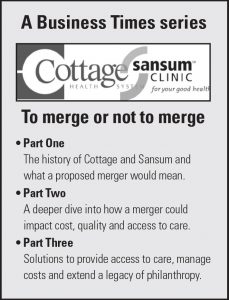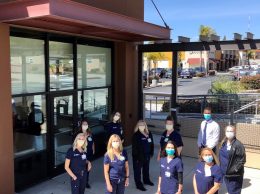
Cottage Hospital wants to merge with Sansum Clinic. Regulators are studying the proposal. (Nik Blaskovich)
It was around 3 a.m. when Emily awoke in a cold sweat. She was short of breath as her fever reached 103 degrees in the midst of an asthma attack.
Emily, whose real name has been changed to protect her identity, drove to Santa Barbara Cottage Hospital where she underwent a series of tests. After some Tylenol that subdued her fever and the aid of a steam inhaler, she could breathe easily again.
They sent Emily home after two hours with some steroids and an inhaler. While she was initially impressed by the thorough exam, that feeling wore off when she saw the bill, Emily said.
“I got the bill and I nearly fell out of my chair. I was outraged,” said Emily, who is an independent contractor and pays more than $700 a month for Blue Shield health insurance. “The original bill was over $7,000, about $2,500 out of pocket, which is just ridiculous.”
Emily’s physician read the billing statement and noticed a charge of $250 for a urine test — a procedure that typically costs about $20 at an independent lab, the physician said.
A similar episode about three years ago cost her about $600. Even a hospital administrator said the charges were quite high, Emily said.
“Now, if I’m not dying, I’m not going to the ER,” she said.
If regulators approve the proposed merger between Cottage Health and Sansum Clinic, Emily worries that the sticker shock from future bills will get worse.
Santa Barbara Cottage Hospital is hoping to celebrate its 125th anniversary by merging with another venerable nonprofit, the Sansum Clinic. Cottage Health’s network of three hospitals would join forces with Sansum’s 23 outpatient sites spanning Santa Maria to Santa Barbara.
Executives at Cottage and Sansum said they couldn’t speak with the Business Times because their attorneys do not want them to comment while regulators wrap up their investigation.
Cottage Health has 3,667 employees throughout many tri-county facilities that offer care from the Ventura County line to San Luis Obispo, including the sole hospital in the city of Santa Barbara. Santa Barbara Cottage Hospital has $751 million in annual revenue and a foundation with $288 million in assets. Sansum has about 1,000 employees, $265 million in annual revenue and a foundation with $122 million in total assets.
Under the terms of the proposal, Cottage would become the “corporate member” of Sansum, bringing the enterprise under Cottage Health. Sansum, which is the only nonprofit medical foundation clinic in California not affiliated with a hospital, would serve as Cottage Health’s medical foundation, according to a news release. Cottage Health would “assure the availability of capital needed to expand health care services for the community through the work of Sansum Clinic and its affiliated physicians,” a news release said.
“Further improvements in quality, outcome and affordability will require formal collaboration among physicians and hospitals,” Ron Werft, president and CEO of Cottage Health, said in a 2013 news release.
The Federal Trade Commission and California Attorney General have spent about three years examining the proposal to weigh antitrust concerns. Cottage and Sansum officials claim that they’d be better together, partnering to decrease cost and improve care. Critics argue that a bigger market share would lead to higher costs and reduced access.
Surging charges
Just to occupy the room, the charge for a class-five emergency room — the highest level — was $1,728, according to Emily’s itemized bill.
Each hospital uses its own fluctuating price list for procedures or services, called a chargemaster, which is used to generate an invoice. Hospitals generally don’t receive the full charge. It hinges on the negotiated contract with insurers.
From 2005 to 2015, the intensive care unit charge per day at Santa Barbara Cottage Hospital more than doubled from $4,050 to $8,195, according to Medicare chargemaster data provided by the Office of Statewide Health Planning and Development. Cottage’s gross revenue growth was 5.7 percent from 2014 to 2015 due to price changes, according to OSHPD data.
The comparably sized Los Robles Hospital in Ventura reported a similar increase in ICU charges, growing from $3,900 to $7,970 over the same period.
“Health care cannot be affordable and universal when you have for-profit interests of hospitals and medical insurance companies,” said Lisa Berry Blackstock, a patient advocate based in the Conejo Valley who has worked with Cottage and Sansum.
One of her cases in Nevada involves a $1,200 charge for a tablet of a widely used antibiotic, she said. “The unregulated price list is the heart of the problem. If you are charging 10 times what the procedure can cost, there’s a huge loophole there.”
Still, Santa Barbara Cottage Hospital tends to, on average, charge less per stay than statewide rates, according to the UC Santa Barbara South Santa Barbara County 2016 Economic Forecast Project.
Some hospitals have taken advantage of a loophole involving observation status, which has caused an increase in out-of-pocket costs, Blackstock said.
Rather than formally admitting Medicare patients, hospitals can place them on observation status — sometimes without notification, she said. The status allows patients to stay at a hospital for fewer than three consecutive midnights without triggering Medicare Part A reimbursement, which covers hospital bills. Under observation status, Medicare Part B reimburses doctors at out-patient rates.
The Notice Act, which took effect in August, requires hospital staff to tell Medicare beneficiaries when they are being held under observation status for more than 24 hours. Patients can expect to begin hearing the warnings come January, but critics worry that the act does not require an explanation of the status implications.
Under the Affordable Care Act, Medicare penalizes hospitals for patients who are readmitted within 30 days of discharge. Hospitals can avoid that penalty because an “observation” technically isn’t an admission, Blackstock said.
“A patient is responsible for the hospital portion of that stay but they only find out when they receive the bill. Every time I have appealed an observation status, which is too many times to count, I have been successful,” she said. “It speaks to the pressure doctors feel as hospitalists.”
The cost of care will continue to increase as health care providers grow, Blackstock said.
“They have more power negotiating contracts with insurers,” she said. “If you are the only game in town, an insurer is more motivated to negotiate a contract with them.”
Blackstock added, “It’s a negotiation game. There’s a lot of ego involved. I don’t think patient care is at the forefront of what goes on. It’s a business deal.”
Executive salaries
As health care providers have grown in size and scale through mergers and acquisitions, executive pay has followed suit.
Cottage’s Werft earned $1.82 million in 2013 in total compensation, according to the hospital’s 990 Form. That included $810,869 in base compensation, $700,565 in retirement and other deferred compensation, $279,660 in bonuses, $12,349 in other compensation, and $17,754 in nontaxable benefits.
Werft earned $1.65 million in 2012 and $1.21 million in 2014.
Chuck Cova, who oversees five tri-county hospitals as Dignity Health’s senior vice present of operations, earned a total of $980,613 in 2014. Dignity CEO Lloyd Dean made more than $8 million in 2014, up from about $6 million in 2012.
Community Memorial Health System CEO Gary Wilde, which includes two hospitals in Ventura County and a dozen outpatient clinics, brought in $1.25 million in 2014.
“Some hospital administrators are making more money than anyone would ever reasonably need,” Blackstock said. “I have people coming to me who have to sell their house to pay a medical bill.”
Bankruptcy blues
Medical debt is the leading cause of bankruptcy nationwide.
Nearly every bankruptcy case attorney Carissa Horowitz of the Santa Barbara firm Beall & Burkhardt has had some sort of Cottage-related medical bill, she said.
Financial Credit Network, Cottage’s contracted debt collection agency, has been less than willing to negotiate, sources said. If a bill from Cottage isn’t paid within six months, the hospital enlists FCN to collect the debt with interest.
Many times, when faced with a compromise, FCN will respond, “Go ahead and file (for bankruptcy),” Horowitz said.
FCN’s biggest bills are with the people who are the least collectible, Will Beall of Beall & Burkhardt said.
“People who do end up paying are paying in premiums and copays for that uninsured care,” he said.
To qualify for Cottage’s Financial Assistance Program, a patient must have an income below 350 percent of the federal poverty level and must not have Medicare, third-party insurance or qualify for Medi-Cal, Healthy Families or other government programs. The federal poverty level for a family of four is $24,300, which means they would have to make less than $85,050.
Medical debt, in most cases, is forgiven in bankruptcy. An automatic stay kicks in when bankruptcy is filed and existing debt collectors must stop making collection requests.
“They call it dunning. It’s a form of harassment,” Horowitz said. “FCN calls a lot. At a certain point you just don’t answer the phone. It’s nonstop.”
Merger waves
Health care providers are using the ACA’s call for Accountable Care Organizations to support consolidations that come with promises of a more efficient system. An ACO essentially requires communication networks across multiple providers.
A similar merger surge in the 1990s was driven by the rise of managed care placing revenue constraints on providers, said Barak Richman, a Duke University law professor with a doctorate in business administration. Providers were complaining that insurers held all the negotiating power and demanded lower prices, spurring highly concentrated provider and insurance markets, he said.
Elected officials need to form policies that make health care markets more competitive, Richman said.
“The more important question is how the FTC should address certain vertical acquisitions and other troublesome conduct by current monopolists,” Richman said in a Q&A with the Association of Health Care Journalists. “This is important because the current policy challenge is not just how to stop additional mergers, but also how to police the monopolies that past merger waves created. Antitrust law is less suited to deal with these challenges.”
Fearing the consequences
If the Cottage/Sansum merger is approved, it could create a self-serving entity that funnels patients through its more costly inpatient care and lures independent physicians with higher pay, sources said.
Speaking with the Business Times under anonymity, an area health care professional said the merger would further tip the scales of Cottage’s current monopoly.
“It would create a bigger group that will control a lot of the patients in the community,” said John, whose name has been changed to protect his identity. “Once in the system, they will stay there, especially if their primary care doctor is a part of Cottage.”
California is one of only a few states that does not allow hospitals to hire doctors, with some exceptions. Santa Barbara Cottage Hospital employs physicians for its teaching and administrative roles.
If Cottage Health controls the medical foundation under the terms of the merger proposal, then it would essentially have the power to hire and fire physicians, according to Santa Barbara Preferred Health Partners, a group of 172 independent physicians in Santa Barbara.
“The foundation model is essentially a loophole in the law that prohibits the corporate practice of medicine. Cottage and Sansum may not see it that way, but that is the fear among the independent physicians,” said Dr. Brent Kovacs, speaking on behalf of the SBPHP executive board. “Independent practice will be threatened. It is already difficult for an independent physician to find new physicians to either join or take over their practices due to financial constraints.”
Cottage would have a disincentive to refer patients to service outside of Cottage, John said.
“Cottage can afford to pay doctors more for primary care basically because they are getting more money on in-house ancillary services,” he said. “The hospital will benefit from facility fees.”
A hospitalist, which are hospital-employed physicians that are the most common types of doctors found at hospitals today, can care for patients around the clock, but they are often wedged between competing interests, critics argue.
There is pressure from hospital administrators to discharge patients to open up the beds and the potential for maximum reimbursement, Blackstock said.
“Interference exists in doctors who are trying to do their job and treat a patient and having to answer to a middle man. That is affecting the quality of care today,” she said.
Reducing competition
Cottage has systematically squeezed out a group of independent orthopedic surgeons, according to a 2009 civil lawsuit.
Dr. Alan Moelleken filed a lawsuit against Cottage for allegedly excluding him along with other orthopedic surgeons from spine surgery referrals. Moelleken argued that the hospital would refer surgeries to neurosurgeons who would reciprocate by admitting them into the hospital instead of a more cost-effective independent facility.
The neurosurgeons threatened to stop performing head trauma surgeries if orthopedic surgeons were placed on the “call panel,” or referral list, according to the suit.
“Defendants have restrained competition in the Santa Barbara metro area by denying health care consumer access to emergency and non-emergency spine care by orthopedic surgeons, decreasing the quality of emergency spine care and steering to higher cost services at Cottage,” the lawsuit reads.
The court ruled in Cottage’s favor. On appeal, Moelleken eventually got a spot on the referral list.
Cottage already has a monopoly in Santa Barbara on inpatient care, Kovacs said.
“This is obvious for anyone who has looked at a bill from a hospitalization or ER visit, where the costs, even after insurance contract adjustments, are many times higher for hospital care than for outpatient care,” Kovacs said on behalf of SBPHP. “Over time, the merged Cottage/Sansum entity could also monopolize outpatient care. There is no doubt that this will translate into disproportionately higher consumer costs.”
If independent practice starts to shrink, the access to care will suffer as patients will have to wait longer for appointments, Kovacs said.
Decision looms
As for the Cottage/Sansum deal, officials at the health care organizations said in July that regulators were close to a decision.
In many ways, Cottage and Sansum already have a symbiotic relationship, which was evident at a recent celebration of Santa Barbara’s new cancer center to be named after philanthropist Lady Leslie Ridley-Tree.
The Cancer Center of Santa Barbara, which merged with Sansum Clinic in 2012, will manage the $68 million facility. More than $33 million has been raised for the center — $10.7 million of which came from Ridley-Tree. Cottage donated $2.5 million, officials said at the Aug. 19 event.
Other than Emily, The Business Times had two other Cottage/Sansum patients who were willing to talk about their medical debt. Yet, they later rescinded the offer for fear that future care would be compromised.
Emily is in the process of filling out paperwork and submitting financial statements to qualify for Cottage’s Financial Assistance Program. She hasn’t been able to secure steady work and has been living on her savings as the threatening collection letters and calls mount.
“I have seen families go bankrupt because of a family member who has cancer,” Emily said. “That shouldn’t happen.”
Health care should be a right, not a privilege, she said.
“My fear is if I have an emergency I am going to be hit by a huge bill. My concern is that there is going to be a monopoly and I am not going to have a choice.”

• Staff writer Alex Kacik was the recipient of a 2016 Center for Health Journalism fellowship at the University of Southern California. Read Part One here and Part Three here. He can be contacted at akacik@pacbiztimes.com.






 Print
Print Email
Email


















Thorough and essential and approachable reporting from Kacik. The Fifth Estate is often the only pushback against this sort of legal malfeasance. Please keep Kacik on the case, and encourage readers to dialog with the paper on these matters in order to begin a conversation in SB on this subject. Let’s all actively question how the regulators’ decisions will affect their care. I believe a for-profit health care system is one that incentivizes excellence. But the price points in that model should be at least vaguely related to ‘what the market will bear’. These hospital bills are fantasy pricing. When you have to sell your home to get cancer treatment the costs are not being molded by market forces, clearly.